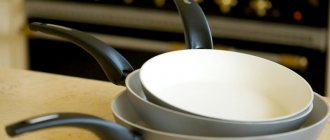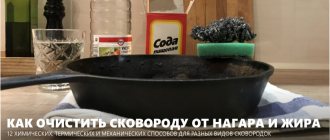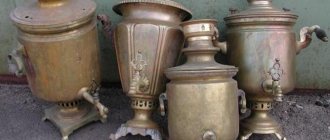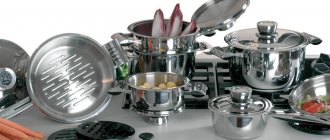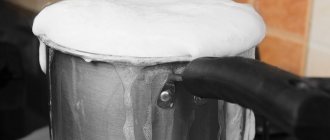Any frying pan will develop carbon deposits over time. It is difficult to wash off with detergents and water. In addition to the spoiled appearance, soot forms substances harmful to humans. Therefore, many housewives have a question about how to clean an aluminum frying pan from carbon deposits at home so that the result is effective and does not damage the coating of the frying pan.
There are several ways to clean an aluminum frying pan from carbon deposits.
What is important to know about aluminum frying pans
An aluminum frying pan has special properties due to the material used. This frying pan is softer and easily comes into contact with the substances in it, and also heats up very quickly. Despite such features, the use of aluminum frying pans is still relevant today; these frying pans are favorites for many housewives.
The specificity of cleaning an aluminum frying pan is that it is sensitive to mechanical influences and cannot be washed with a regular scraper.
Cleaning old aluminum cookware
But how to clean an aluminum frying pan if it has been in use for many years and the remaining fat on it has turned into an impenetrable shell? In this case, salt will help. Take a spacious container that can be placed on the stove. A sufficient amount of water is poured into it and half a standard pack of table salt is added. The pan to be cleaned is placed in a large saucepan and left to simmer for two hours.
Salt will help deal with heavy deposits on the pan.
Methods for cleaning old carbon deposits from an aluminum frying pan at home
Carbon deposits are one of the most common types of contamination for frying pans. It is quite difficult to wash it, but using proven methods it is possible. Over time, carbon deposits form on all frying pans, and this is a process from which it is impossible to completely protect yourself, which is why it is so important to clean the frying pan from it in a timely manner.
There are several proven modern and traditional methods of dealing with soot.
Incandescent
Heating is the best way to clean burnt-on grease and other dirt. This method is quite effective, but when using it you should be careful and approach the process with the utmost care.
There are several ways to deal with this problem using incandescence; the simplest is to simply put the frying pan in the fire. When it is hot enough, you should take it out with a tack and clean the carbon layer by layer.
This folk method has shown good results for years and made it possible to get rid of unpleasant soot.
A more specific method is to use a blowtorch. To do this, you need to carry out internal and external treatment using fire.
With this method, the carbon deposits will gradually peel off from the pan.
A long, but no less effective way would be to heat it on the stove. However, this will take several hours, and it is important that the room is ventilated, since this method will release a pungent odor. It is also possible to heat fine sand poured inside; this method will also require several hours.
After the procedure, heated carbon deposits can be easily removed with a sponge or spatula.
Household chemicals
For modern cleaning, housewives can use various household chemicals. They are excellent at helping to combat soot and burnt fat. Using these products allows for quick cleaning.
Using various household chemicals, housewives determined how to effectively clean an aluminum frying pan using household chemicals from old carbon deposits. The following cleaning agents are best suited for this purpose:
- Mister Muscle;
- Schumann;
- Helper;
- AmWay;
- Frosch;
- Oxyday.
Store-bought cleaning products can be very caustic because they contain various acids and alkalis.
The listed substances are ideal for cleaning, but it is important to follow the instructions written on the packaging. The cleaning process is quite simple, you just need to apply the product to the surface and wait a couple of hours. Afterwards, it will be enough to simply run a sponge over the frying pan and remove the exfoliated carbon deposits.
The easiest way to clean an aluminum frying pan from carbon deposits is to use chemical cleaning agents.
When using this method, several important factors must be taken into account. All household chemicals are partly toxic, and therefore the process should be carried out only with rubber gloves and in a ventilated area. Another disadvantage for many is the high cost of products, which is why many housewives prefer traditional cleaning methods.
When working with them, you must wear rubber gloves.
Mechanical cleaning
This cleaning method is excellent for external use. Using a grinder or drill with a wire brush will quickly give the pan its former appearance. It is important to carry out this treatment only on the outside, since using it inside the frying pan can damage the protective layer. You should also wear gloves and safety glasses when working.
The carbon deposits from the pan will fly off in small pieces and can cause damage.
How to clean old grease
If the use of vinegar, soda, powder, or another method does not help, then the carbon deposits are already old. It is firmly ingrained and is not easy to remove. In this situation, the most effective are:
- heating (many people simply put a frying pan on a fire or “fry” fine-grained sand in it);
- chemistry listed above;
- cleaning with a drill and grinder;
- laundry soap (sprinkle the frying pan generously with soap shavings and pour boiling water over it);
- ammonia.
Traditional methods
Our grandmothers also faced the problem of carbon deposits on an aluminum frying pan, and they did not have the opportunity to use universal household chemicals. At the same time, their frying pans always looked like new, thanks to the use of folk cleaning products. Nowadays, not everyone trusts household chemicals and still uses proven and effective folk methods.
Grandmother’s “liquid” method
To use this method you need the following ingredients:
- half a kilogram of soda;
- 200 grams of silicate glue;
- a piece of laundry soap;
- 10 liters of water.
Our grandmothers knew how to clean an aluminum pan without much effort.
How does the cleaning process work?
- First you need to find a large container, fill it with water and start heating it.
- As soon as the water heats up, you need to rub soap into it, pour in glue and add soda.
- It is necessary to mix everything thoroughly so that no small pieces of soap remain and all components become a single mass.
- Next, you should wait until the resulting mass boils and completely lower the pan into it.
- You should wait an hour and a half.
- After the required amount of time has passed, some of the carbon deposits will come off on their own. The remaining part can be cleaned with a soft brush.
The cooled dishes are brought to complete cleaning with a not very hard brush.
Soap and soda solution
This method also requires a large container where the cleaning process will take place. You will need the same ingredients as from the previous paragraph, only without adding glue. The process is exactly the same; after the cleaning time has passed, all carbon deposits can be easily removed with a soft brush.
A solution of baking soda and soap will help remove carbon deposits.
Boiling in soda solution
For this method, you need to add the required amount of water so that the pan is completely immersed in it. Then add one tablespoon of soda for every liter of water.
An even simpler but effective cleaning method is boiling it in water with soda.
It only takes ten minutes to boil the pan in this composition. Next, you should leave the pan in this solution for another half hour. After time has elapsed, carbon deposits from the frying pan can be easily removed using a regular sponge or brush with soft bristles.
Another way to use baking soda is if you only need to clean the inside. Pour water into the pan, add a little vinegar and two tablespoons of soda. After the resulting solution begins to boil, you need to add another 50 grams of salt and turn the heat down. The whole process must be completed until the water has completely evaporated and then simply rinse everything off with warm water.
For safety reasons, you should use a mask.
Laundry soap with soda and glue
Another effective way to clean the inside of a pan. To do this, you need to fill it halfway with water and add grated laundry soap, a little soda and glue. All this must be mixed thoroughly and put on fire. It is necessary to boil for half an hour, then let it cool and after a couple of hours rinse thoroughly.
The resulting mass must be brought to a boil.
Washing powder and oil
You need to fill a bowl with water and add a little powder and a few tablespoons of sunflower oil. Place the basin on medium heat and place the frying pan there. The resulting solution must be brought to a boil, turn off the heat and let cool, and then simply wash the pan in the usual way.
According to many connoisseurs of folk methods of dealing with soot, this method is the best.
Vinegar solution
To use this method you will need the following ingredients:
- One hundred grams of salt;
- 250 grams of table vinegar;
- Two tablespoons of soda.
In order to clean using this method, you need to pour a thin layer of salt onto the bottom of the pan. Then you should pour vinegar over everything and put it on the stove to boil. As soon as the resulting liquid begins to boil, add soda. You need to boil everything until the liquid is completely removed.
The entire process should be carried out with rubber gloves and in a necessarily ventilated area.
To subsequently remove the burnt mass, use a brush with soft bristles.
Lemon solution
Using citric acid, clean the inside of the pan. To do this, you need to put it on the stove, pour water and add a teaspoon of citric acid powder. Then you should boil the resulting liquid for five minutes. Then let it cool and wash as usual.
Cleaning a frying pan with lemon solution.
It is also possible to clean the entire pan using this method. To do this, you need to prepare a large container where the frying pan can fit, then pour in water and add a teaspoon of citric acid for each liter of water. Boil the resulting mixture for half an hour, then let it cool and wash.
Modern means for washing frying pans
Several modern products that have proven themselves in cleaning carbon deposits:
- Schumann . Product made in Russia. Quickly dissolves stains not only on the stove, but also on dishes. It has a pungent odor, so the room must be ventilated. Inhalation of Schumanite vapors leads to burns of the respiratory tract and chemical poisoning. Be sure to use household gloves. Sold in various quantities. There is a package with a spray bottle. Cost - from 350 rubles. for 400 ml.
- Mr. Muscle is a universal kitchen spray. Has a lemon scent. Packaged in a plastic bottle with a spray bottle. The product is gentle but effective. Quickly copes with tasks and disinfects treated surfaces. Price for 500 ml - from 250 rubles.
- Cillit Bang anti-fat . The product is known thanks to advertising. Copes well with greasy, old carbon deposits and other contaminants. Universal, suitable for washing stoves, ovens, ovens. Packaging with a spray bottle allows you to use the cleaner economically. The price is affordable - from 250 rubles. for 700 ml.
- Sanita . Deals with grease and carbon deposits on kitchen appliances and utensils in 1 minute. To remove old dirt and plaque, spray the product and leave it on for 15-20 minutes. Cost - from 150 rubles. for 500 ml.
How to clean an old frying pan from external carbon deposits
Abrasives cannot be used to clean the inside, but they can be used on the outside. For this you can use a knife, a scraper made of metal, as well as fine-grained sand and salt. To better clean the carbon deposits, you should first boil the frying pan in water and then begin processing.
All small scratches that have formed can be easily polished with soda, which allows you to restore the appearance of the outer part.
Procedures for restoring the protective layer
In addition to the question of how to remove carbon deposits from an aluminum frying pan, many housewives are interested in the question of how to restore the protective layer at home? It is no longer possible to completely restore the layer, but partial restoration can be achieved so that the food does not burn.
For the partial restoration process, it is necessary to grease the frying pan with sunflower oil or lard. It is then placed in the oven upside down. The oven temperature should be 180 degrees. After an hour, turn off the oven and allow to cool.
Before the next cooking in a frying pan, it should lie for a couple of days.
How to restore the protective layer
After careful cleaning, it is often discovered that the non-stick layer of the pan has been damaged. Well, it won’t be possible to restore it completely, but it can be partially restored.
They do this:
- Lubricate the damaged areas with fat. Lard is better, but you can also use butter.
- Turn on the oven at 180 °C.
- Place the frying pan inside the oven, placing it upside down.
- Leave for 1 hour. Turn off the oven and let the pan cool without removing it.
- If necessary, repeat the procedure, but only after cooling.
Preventive measures against the formation of burning
In order for the frying pan to last longer, it is necessary to calcinate it before using it for the first time. Salt or oil is suitable for this. Pour oil until it completely covers the surface of the pan and then heat it on the stove until it smells like burnt oil.
After an aluminum frying pan is as good as new, it needs to be helped to regain its lost characteristics.
When using salt, pour it onto the surface in a centimeter layer and prick it for 10 minutes. Thanks to this method, a special film is formed that protects against soot.
Before use, in both cases the pan needs to sit for a couple of days.
Preventing carbon deposits
It is much easier to prevent carbon deposits than to fight it. Basic preventive measures:
- A new frying pan is heated before first use. Salt (1 cm layer) or sunflower oil (2 mm) is “fried” in it. Remove from heat after 10-15 minutes.
- After each use, wash the pan until the fat has completely hardened. And before the next use, you need to make sure that there is no old fat left, because it forms soot in the first place.
- If part of the dish remains in the pan (overnight or even for several days), that’s okay. But before heating this dish, you need to stir it to prevent burning.
Common cleaning mistakes
Many housewives use conventional cleaning products, not realizing that this has a detrimental effect on the aluminum coating. Another particularly common mistake is using metal brushes to clean the inner surface of the pan.
You should not use household chemicals that contain aggressive elements that can damage the protective layer.
What you need to know first
Aluminum utensils are very unstable to aggressive measures, so it is better not to use them for cleaning at home. These methods include:
- Household chemicals. Special carbon cleansers are useful only for cast iron or Teflon frying pans; strong substances are best suited for these surfaces. But they can irreversibly destroy your favorite aluminum cookware, which can affect both the quality of the food that will be cooked on it and the safety of the cooking process.
- Hard brushes. Abrasive bristles can damage the surface of the utensil, it will lose its shine and positive properties.
- Dishwasher safe. Aluminum pans can only be washed by hand using sponges or soft bristle brushes.
Soot is burnt fat that has accumulated layer after layer on the walls of the frying pan. It creates not only an aesthetic problem, but also harms your health and the health of your loved ones. The soot itself contains quite a few harmful substances, but food cooked in such a frying pan, and especially burnt food, carries much more harm. So if you're in the habit of putting off fully cleaning your pan, it's best to do it as soon as possible.
Recommendations for caring for an aluminum frying pan
When cooking in an aluminum frying pan, it is advisable not to be distracted from the process. It is advisable, if possible, to avoid cooking certain foods, which in any case will leave behind soot. If this is not possible and carbon deposits still appear, you should immediately get rid of it using the correct method.
You should follow certain recommendations so as not to encounter unpleasant soot.
Removing burnt food from the pan
An aluminum frying pan needs to be cleaned every now and then to remove burnt food, because it does not have a non-stick layer. You can clean aluminum dishes at home by boiling them in water with citric acid. Two teaspoons are enough to soften food residues, which can be easily removed from the pan after processing. Instead of citric acid, it is permissible to use vinegar or lemon juice.
If it’s summer outside and there is an opportunity to pick sorrel, then it will also help clean the frying pan; you need to place it in it and fill it with water. Let the “dish” boil; the remaining food will come off easily.
Features of aluminum and duralumin frying pans
It is customary to distinguish 3 technologies for the production of aluminum cookware:
- Stamped. This method is the cheapest and involves making a frying pan by cutting and stamping a finished aluminum sheet. As a result, the walls of the dishes are thin and excessively flexible. They are easily damaged and deformed, their service life is no more than 3 years.
- Forged. Forged aluminum products are quite durable. They are produced by pressing metal using a special apparatus. The bottom of the cookware is often equipped with steel plates.
- Cast. Making a cast aluminum frying pan is an expensive process that involves pouring molten material into molds of a specific configuration. During the production process, the metal retains its beneficial qualities. Cast cookware is characterized by durability and the ability to heat evenly.
Aluminum kitchen items are made of aluminum with an admixture of other metals: copper, magnesium, iron and silicon.
About the dangers and benefits of an aluminum frying pan
Aluminum and aluminum frying pans have the following advantages:
- low cost;
- light weight of products;
- uniform heating;
- cast aluminum does not corrode;
- possibility of preparing dishes without adding oil;
- harmlessness to human health;
- easy cleaning process.
The main disadvantages of aluminum frying pans:
- high probability of deformation under mechanical stress;
- Cookware made of duralumin without a non-stick coating may rust;
- the aluminum surface can be easily scratched with a sharp object;
- any damage to the coating negatively affects the quality of the food;
- Excessive heat causes food to stick;
- susceptibility to oxidation.
Getting rid of rust
Cleaning cast iron pans often involves not only removing carbon deposits, but also getting rid of rust.
What do we have to do? The work algorithm is as follows:
- Standard cleaning is carried out to remove carbon deposits and “expose” areas with rust.
- After washing, the pan is dried and placed in a well-heated oven (120 degrees) for 40 minutes.
- Take out the heated frying pan, grease it with oil and put it back in the oven (temperature - 230 degrees), where it is kept for an hour. The bottom of the oven should be protected with foil.
- We take out the dishes and grease them with oil again when they have cooled.
In principle, this procedure can also be carried out to ensure that food does not stick or burn to the bottom during cooking.
https://kitchendecorium.ru/poryadok/sposoby-effektivnoj-ochistki-skovorodki.html
How to prepare a frying pan for use
Wash the new frying pan with warm water and laundry soap or liquid dishwashing detergent. This will remove any remaining technical dirt and dust.
A new frying pan must be prepared before use.
A frying pan without a non-stick coating is prepared for use using salt or vegetable oil. There are several ways.
Method with water, without salt:
- Boil water in a frying pan.
- Drain and let the dishes dry.
- Wipe the product with vegetable oil and leave for 2-3 days.
Method with salt, without water:
- Add salt to cover the bottom.
- Heat for 10 minutes over low heat, let cool.
- Pour in salt, wipe with vegetable oil, and leave for 2-3 days.
Oven method:
- Lubricate with vegetable oil outside and inside.
- Place in the oven preheated to 120–150 0C for 1 hour.
- Turn off the oven, leaving the pan in it for another 2-3 hours.
Method of heating oil with salt.
- Pour in vegetable oil to cover the bottom.
- Add 1 teaspoon of salt and stir.
- Heat over low heat until a characteristic smell appears.
- Let cool.
- After processing, rinse the pan again with water without detergents.
The resulting thin oil film will serve as a non-stick coating.
Video: how to prepare an aluminum frying pan for use
Gentle cleaning
If the layers have formed recently and have not yet had time to firmly attach to the walls of the frying pan, you can use the following methods.
First, you can clean the pan using an apple. This method will not save you from stubborn carbon deposits, but it can return your favorite dishes to their original appearance in the initial stages of contamination. A fresh apple must be cut in half and cut across all the walls of the dish, then washed with warm water and detergent. After such exposure, greasy stains will be removed, and the aluminum will regain its original shine.
Secondly, if there is no clearly noticeable layer yet, but the food has already begun to burn, and the fat has already become ingrained and cannot be washed off with conventional means, you can use ammonia. First you need to soak the frying pan in hot water for 20 - 30 minutes, then add 0.5 teaspoon of ammonia to a small amount of laundry soap solution. Use this mixture to thoroughly clean the pan, after which stubborn dirt will be removed and the shine will return. If you are unable to remove the carbon deposits using this method, you can try using wine alcohol instead of ammonia.
Using household chemicals to combat carbon deposits
The easiest way to clean an aluminum frying pan from carbon deposits is to use chemical cleaners. Their range is so diverse that it makes no sense to name any specific manufacturer. Every housewife probably has a couple of proven brands. But here we must take into account that store-bought cleaning products can be very caustic, since they contain various acids and alkalis. Therefore, when working with them, it is necessary to wear rubber gloves, ventilate the room well, and rinse the dishes thoroughly after cleaning with such substances.
Store-bought cleaning products can be very caustic because they contain various acids and alkalis.
Treatment after cleaning
To restore the beautiful appearance of aluminum cookware, it is recommended to rinse it in a weak mustard solution after cleaning. Alternatively, you can use a mixture of table vinegar and water.
After cleaning, you should prepare the aluminum frying pan for use. To do this, perform the following steps:
- Coarse salt is poured into the dishes in an even layer a couple of millimeters thick.
- Salt is filled with sunflower oil.
- The frying pan is placed on the fire and heated until the smell of hot oil and white smoke appears.
- After cooling, the contents are removed, the dishes are washed with warm water and soap and dried.
How to care
Only proper care will keep the aluminum product in working condition. Here are a few rules that you can follow to achieve your goal:
- A new frying pan must be heated.
- You should not use such utensils every day.
- Cooked or heated dishes should be transferred to a bowl. Otherwise, the food will have an unpleasant aftertaste. And the surface of the object itself darkens.
- Do not place food containing acids on the frying unit. The reaction of aluminum with them produces harmful substances.
- Cooking and heating food is carried out over low heat to avoid scale formation.
- Food is often stirred to prevent sticking, using spatulas made of wood, plastic or silicone.
We also recommend reading: Functional microwave oven - Wollmer E305
